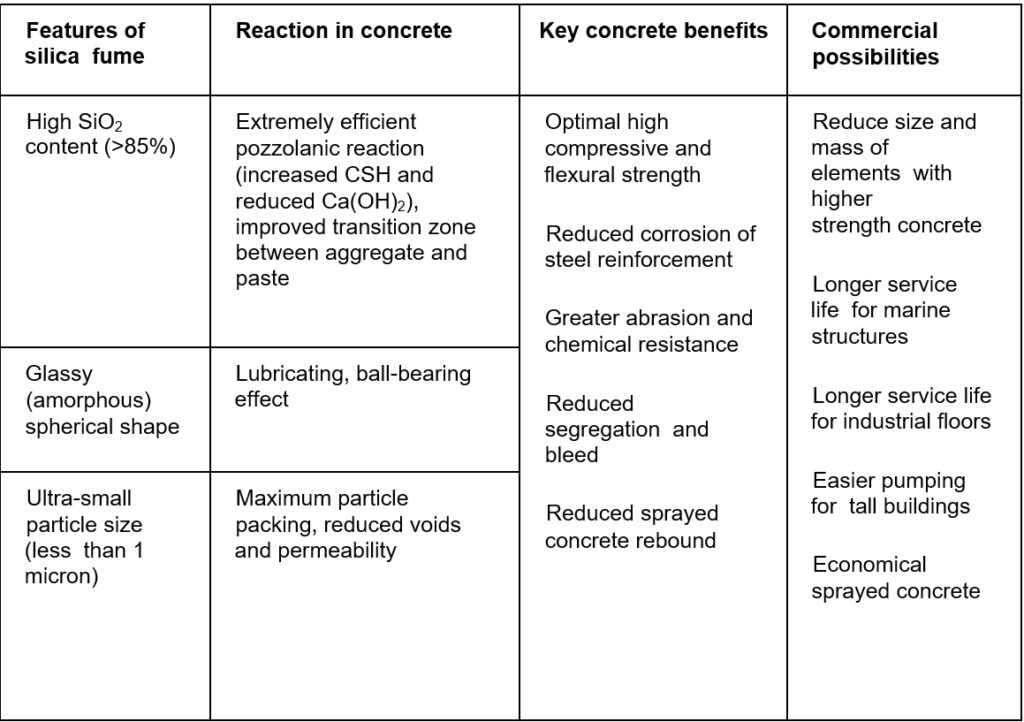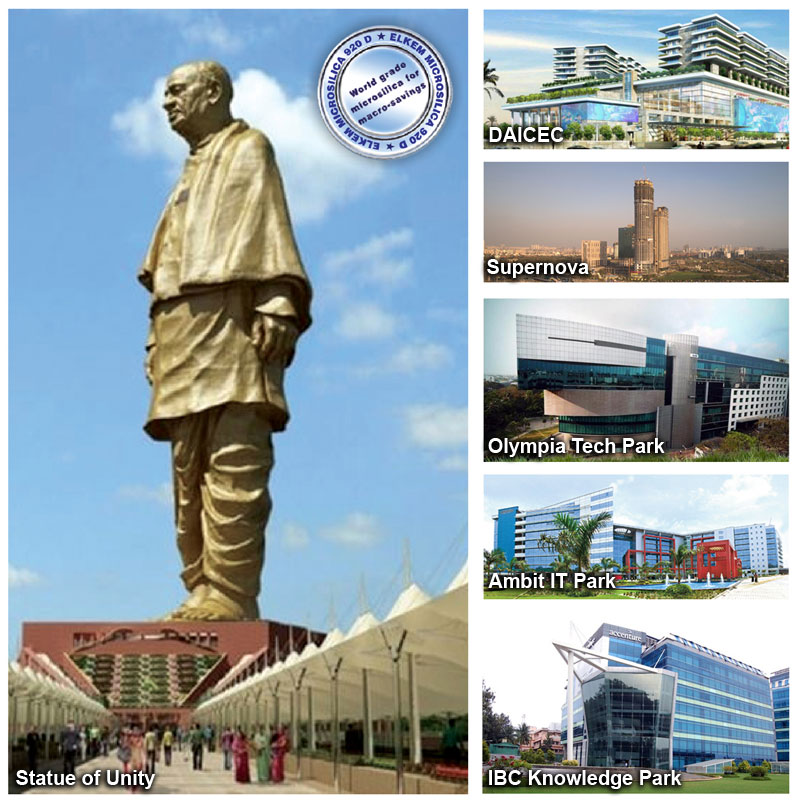Silica Fumes has been used as a mineral admixture to improve concrete properties since the 1950s. Commercial development of the material began in the 1970s with Elkem Microsilica® being a registered trademark belonging to Elkem Silicon Materials of Norway. The term ‘microsilica’ is commonly used in many countries to describe silica fumes.
Silica fume imparts a range of important benefits to concrete. It is extensively used in construction, such that it is now estimated that more than 10 million cubic metres of high performance silica fume concrete are produced worldwide every year.
International Standards for silica fume include ASTM C 1240 published by ASTM International and EN 13263 published by European Committee for Standardization and in India it is IS 15388:200
PRODUCTION OF SILICA FUME
Microsilica is an industrial by-product, produced during the manufacture of metallurgical silicon. Around 350−500kg of silica fume arises for every tonne of metallurgical silicon produced.
Silica fume can be defined as ultra-fine particles of amorphous silicon dioxide. Each particle is spherical, sub-micron in size and with SiO2 content in the range 85−99% (Figure 1). The ultra-fine particles improve particle packing and produce a highly pozzolanic reaction in the concrete mixture, leading to:
- Reduced permeability, therefore reduced ingress of chloride & other harmful agents and resulting in greater protection for reinforcing steel, especially in critical infrastructure e.g. marine structures
- Higher strength
- Higher abrasion & erosion resistance

The benefits of silica fume in high performance concrete are summarised in Table 1.
Table 1 Features and benefits of silica fume

HANDLING AND MIXING SILICA FUME
During production, silica fume initially takes the form of an ultra-fine (average particle size 0.15 micron) dry powder and has very low bulk density. To aid handling, the silica fume powder is usually subjected to a ‘densification’ process, thereby increasing the bulk density from around 300 to 600kg/m3. In this densified form, the ultra-fine silica fume particles are agglomerated loosely together. The product can then be delivered in bulk or bags to the concrete plant. During mixing at the concrete plant, it is important to ensure the densified silica fume agglomerates are broken down, reverting to their primary, ultra-fine condition with full dispersion throughout the concrete mixture. This is achieved through correct batching sequence, efficient mixing plant and adequate mixing time. Due to its high surface area (typically ca. 20,000m2/kg), silica fume concrete requires the use of a superplasticizer to achieve appropriate water/binder ratio.
Silica fumes tend to reduce or eliminate bleed water; it is imperative that a suitable curing regime must always be enforced at the construction site [1].

CURRENT USES OF SILICA FUME CONCRETE
Protection from corrosion for steel reinforcement
Concrete structures requiring strength and durability in a high chloride environment, such as harbours and marine bridges, are a major application for silica fumes. For example, Bandra Worli Sea Link Bridge in Mumbai used high performance silica fume concrete. The required strength and marine durability were achieved using M50 grade (with 10% silica fume) for the piles and M60 silica fume concrete for the pile caps, piers and precast segments.
Severe chloride environments, such as marine structures and projects in the Middle East, utilise silica fumes for maximum service life. In the Middle East, it is common for a maximum chloride permeability of 1000 coulombs to be specified (ASTM C1202-09 method). Typical silica fume concrete mixtures supplied to these projects achieve around 500 coulomb or less.
Shotcrete and tunnels
Silica fume is also specified for tunneling projects, both for sprayed concrete and precast segments. For sprayed concrete, silica fume improves both the fresh rheology and the long term durability of the concrete. In precast, it is used to increase both strength and durability.
Abrasion resistance
Applications requiring exceptionally high abrasion resistance, such as heavy duty industrial floors, coastal sea defenses and military pavements specify high performance silica fume concrete. For example, a number of hydroelectric dam structures in India, e.g. Chamera, Salal, and Tehri, have utilised high performance silica fume concrete to reduce erosion and abrasion damage in the spillways and stilling basins.
Silica fumes will increase the abrasion resistance of concrete through increased strength of the matrix and the improved bond between matrix and aggregates.
Tehri dam, constructed on the Bhagirathi river in North India, is a 2000MW hydroelectric power plant with an earth and rockfill dam and several chute and shaft spillways. The water velocity in the spillways has been recorded up to 45-50 m/s with circular motion especially at the junction of the vertical and horizontal shafts of the shaft spillway, creating high risk of having severe cavitation damage along the lining of the spillway. A large amount of fine sand and silt is carried in the river, posing a high risk for abrasion-erosion damage to the hydraulic structure [2].
For the Tehri dam project, laboratory trials were conducted using various concrete grades, with and without silica fumes. The abrasion-resistance test method used was ASTM C 1138. This method uses steel balls in water stirred by paddles at 1200 rpm to simulate the abrasive action of waterborne particles such as silt, sand, gravel, and boulders. The results of the laboratory trials are shown in Table 2. A high performance M70 concrete mix with 10% silica fume showed least abrasion loss and was selected for use in the construction project.
Table 2: Mix Design and Results, Tehri Dam Laboratory Trials
| M30 | M50 | M60 | M70 | |
| Cement, kg/m3 | 317 | 340 | 365 | 380 |
| Silica fume, kg/m3 | 0 | 10% | 10% | 10% |
| Aggregates, kg/m3 | 1900 | 1934 | 1909 | 1890 |
| Water, kg/m3 | 143 | 142 | 140 | 130 |
| w/b ratio | 0.45 | 0.38 | 0.35 | 0.31 |
| Strength 3 days | 20.89 | 29.33 | 43.29 | 51.16 |
| Strength 7 days | 28.13 | 43.82 | 56.49 | 60.85 |
| Strength 28 days | 35.73 | 56.18 | 68.23 | 75.4 |
| % abrasion loss, 72 hrs | 6.26 | 3.06 | 2.88 | 2.75 |
High rise buildings and pumping
Silica fume is routinely used in the construction of the world’s tallest buildings. Classic examples include the Burj Khalifa in Dubai and the Petronas Twin Towers in Kuala Lumpar. This type of structure requires a high performance concrete, which is typically based on a ternary blend of binder. The aim of a ‘triple blend’ is to economically optimise strength, durability and placement. For example, the Guangzhou International Finance Center, designed by Wilkinson Eyre and completed in 2010 is 432m tall with 103 floors and for this project a ternary blend silica fume concrete mix was used to improve pumpability and achieve high strength. The structure is a column-in-column design, with a reinforced concrete core tube and an exterior frame of concrete filled steel columns. Some 70,000m3 of high strength concrete was supplied, including C90 pumped to 168m height and C80 pumped to 410m. Details of the C80 concrete mixture are shown in Table 4.
Table 4 C80 mix design, Guangzhou International Finance Center
| P11 42.5 R (GB175- 2007 ‘Common Portland Cement’) | GGBS | Silica fume | Superplasticiser | Water/binder ratio | Consistence |
| 420kg/m3 | 142kg/m3 | 20kg/m3 | PCE | 0.26 | 220−260mm |
Ultra-high strength concrete
Ultra-high strength concrete (UHSC) technology has been extensively researched by the academic community. There is growing awareness of the commercial value of these higher performance concrete. A typical UHSC mixture could have a water/binder ratio around 0.15−0.20 and a 20% silica fume dosage (of total binder mass). The silica fume contributes towards the high strength through (a) highly efficient pozzolanic reaction and (b) optimised particle packing. To help design a UHSC mixture with optimal particle packing, computer software such as those based on the Andreassen model can be used [3]. Recent research in Norway has demonstrated that UHSC can successfully be made using locally available, common materials. Understanding the synergy between silica fume and superplasticizer in the UHSC is critical to achieve the very low water/binder ratio required by UHSC. This is an area of research now being progressed by Elkem.
Self-compacting concrete
Self-compacting concrete (SCC) mixes can be sensitive to fluctuations in material properties and batching accuracy, potentially leading to issues of segregation or variations in consistence. This can make large-scale supply of SCC from ready-mixed plants more difficult and onerous. To overcome this issue and improve the robustness of self-compacting concrete, a relatively low dose of silica fume (for example, 5% silica fume by weight of total cementitious content) is effective
Since first becoming commercially available in the 1970s, silica fume has steadily established itself as a versatile and reliable material. It is being used to produce high performance concrete in a wide range of projects around the world. Higher performance concrete can play an increasingly significant role in improving the sustainability of concrete construction, by improving the durability and service life of infrastructure and by enabling structural design improvements such as reduced column sizes. One such product is Elkem Microsilica®.
Elkem Microsilica® for high-performance concrete
Elkem is the world’s leading manufacturer and supplier of silica fume, having first introduced Elkem Microsilica® to the market in the 1980s. Elkem now offers a range of silica fume products tailored for a wide range of construction applications, including concrete, fibre cement, and gypsum boards. Elkem Microsilica® is used to achieve (ultra) high-performance concrete. It gives significant benefits to concrete including reduced construction times, improved pumpability, enhanced early strength development, reduced formwork, reduced consumption of steel, reduction in concrete sections. Reduced dead load on foundations and excellent durability, particularly resistance to abrasion, and chemical attack.
Elkem Microsilica® improves the performance of concrete and mortar formulations. It acts physically to optimize particle packing of the concrete or mortar mixture and chemically as a highly reactive pozzolan. It is available worldwide and is certified to relevant local Standards as applicable, for example, EN 13263 ‘Silica fume for concrete’ or ASTM C1240 ‘Standard specification for silica fume used in cementitious mixtures. Moreover, when PPC or Slag is the only option, incorporating Elkem Microsilica® helps to offset disadvantages such as the consumption of more cement Per m2 for an equivalent grade of OPC concrete.

Elkem Microsilica® is used in many projects across India such as the Statue of Unity for hydration control and Dhirubhai Ambani International Convention and Exhibition Center (DAICEC). Other structures include Supernova at New Delhi, Olympia Tech Park and AMTI park in Chennai, IBC Knowledge Park, Bangalore and many more. These all are standing testimonials of the cost efficiency of the product. It has also been used in many landmark structures across world such as Burj Khalifa, Jumeirah Beach Residences in Dubai, Four Seasons Hotels and Condos in Miami, Two Union Square in Seattle, One Island East in Hong Kong, Ceylinco Celestial Tower in Colombo, Marathon Nextgen, Palais Royale, World One, Minerva Tower, Oasis Tower and many more.
To know more details about the product visit- https://www.elkem.com/about-elkem/our-plants-and-locations/worldwide-presence/silicones-elkem-south-asia-pvt-ltd/
Authored by;

About the Author:
Surendra Sharma has extensive experience with cement and concrete industries for more than 20 year with special emphasis on high performance concrete and has special interest in making sustainable and durable and better concrete and presently working with Elkem since more than 10 years.
He has 20 + year experienced in different facets of civil engineering including project execution of high rise residential buildings such as Burj Dubai, public buildings and mass housing projects.
Info references-
- SILICA FUME ASSOCIATION. Silica fume users manual. USA, April 2005, available from http://www.silicafume.org/concrete-manual.html
- MANN P P S AND VISHNOI R K. Abrasion erosion resistant high performance concrete at Tehri dam project – A case study, Proceedings, Workshop on High Performance Microsilica Concrete & Shotcrete application in Hydropower Projects, 28 April 2006, NCB, Ballabgarh, India
- EMMA (ELKEM MATERIALS MIX ANALYSER), COMPUTER software available from Elkem.

